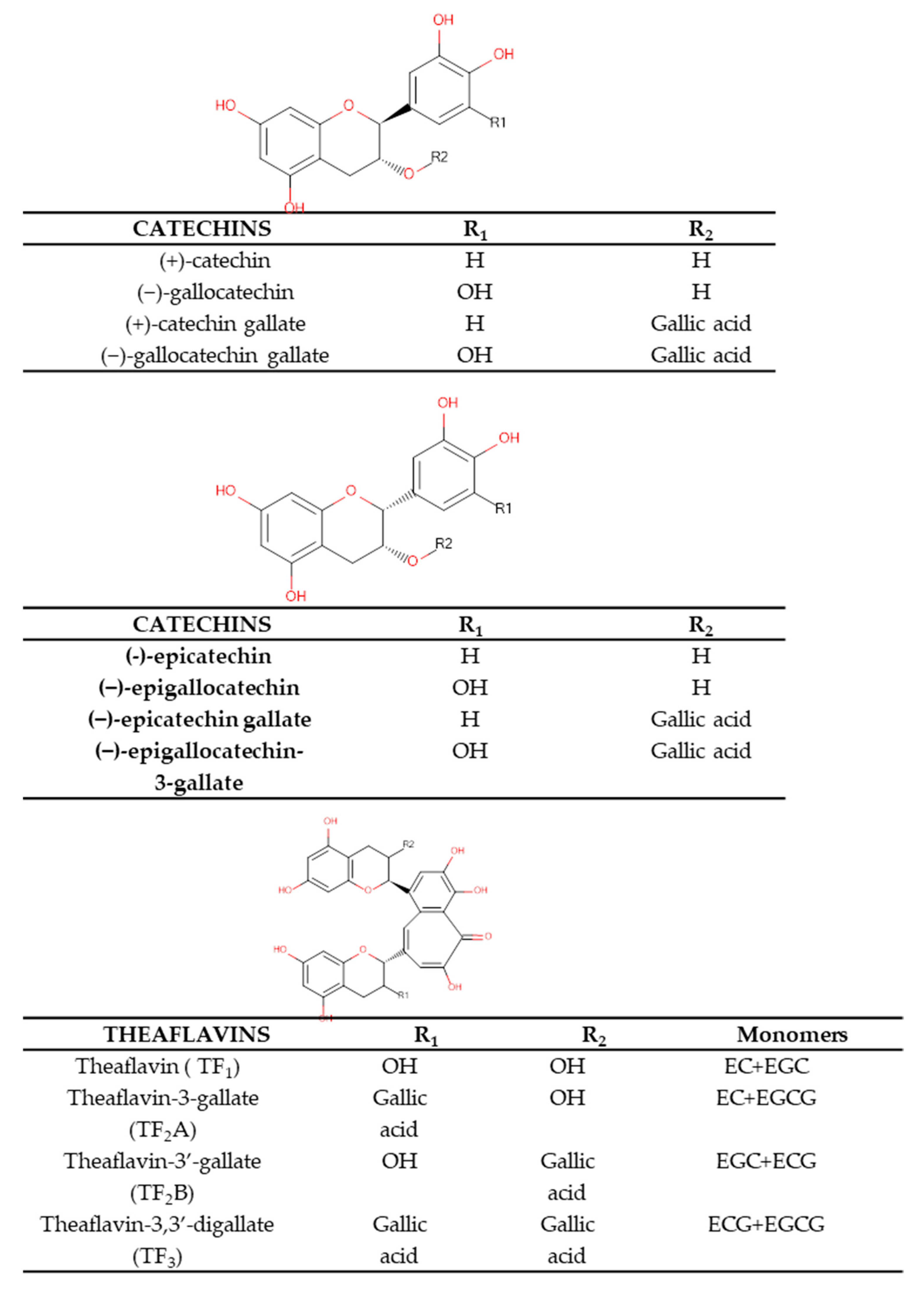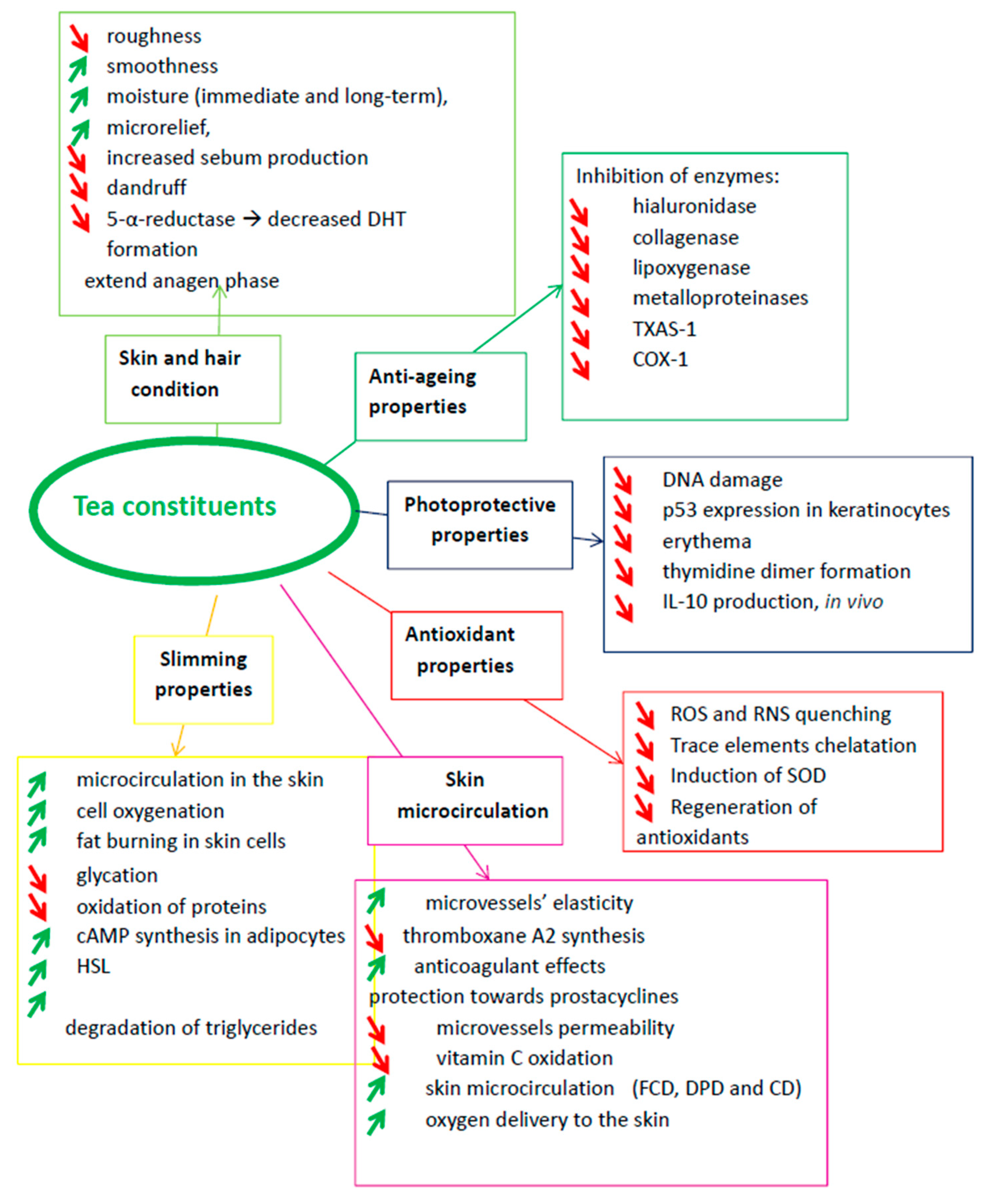Tea plant itself and its extracts together with their centuries-old tradition of use play an important role on the cosmetics market. In general, cosmetics products containing tea extracts rich in polyphenols have a positive effect on the skin appearance and ameliorate skin damage, erythema and lipid peroxidation following UV exposure.
- tea plant
- skin care cosmetics
- dermatology
- Camellia sinensis (L.) Kuntze
- catechins
- Theaceae
1. Introduction
2. The Chemical Composition of Tea Plant (Camellia sinensis (L.) Kuntze)

3. The Application of Tea Extracts in Cosmetics

 —stimulation,
—stimulation,  —inhibition).
—inhibition).4. Skin Penetration of Tea Active Constituents
5. Skincare Products Containing Tea Extracts
|
Tea Extract |
Cosmetic Product |
Cosmetic’s Effects (Manufacturer′s Declaration) |
Production Area |
|---|---|---|---|
|
Green tea |
Peeling mask |
- Improved skin regeneration based on the antioxidant, anti-inflammatory and toning properties of green tea |
Poland |
|
Green tea |
Face mask |
- Strong soothing, anti-inflammatory and regenerative properties - antioxidant activity - Protection against harmful environmental influences |
Poland |
|
Green tea |
Face mask |
- Eliminated excess sebum - Proper skin hydration |
USA |
|
Green tea |
Shampoo |
- Hair care for normal and slightly damaged hair - Antioxidant properties - Soothing action towards sensitive scalp (slightly moisturized and refreshed) |
Poland |
|
Green tea (Fuji) |
Shampoo |
- Hair care for normal hair - Refreshed and purified hair and scalp |
UK |
|
Green tea (Matcha) |
Shampoo |
- Reduction of dandruff and greasy hair - Clarified and toned scalp - Intensive shine |
UK |
|
Green tea |
Shampoo |
- Antioxidant in hair care (protection of hair against free radicals) - Hydrated and moisturized scalp |
Malaysia |
|
Green tea |
Hair conditioner |
- Hair care for all hair types - Protection against moisture loss - Strong antioxidant and hair growth stimulant properties - Smooth and soft hair |
UK |
|
Green tea |
Hair conditioner |
- Strengthens hair - Antioxidant properties towards hair |
Japan |
|
Green tea |
Hand and Body Lotion |
- Nourishing cream for feet, hands and body - Makes the skin smooth and hydrated |
USA |
|
Green tea |
Body lotion |
- A fresh fragrance - Refreshing body and mind - Improved mood |
USA |
|
Green tea |
Balancing lotion |
- Superior hydration and nourishment of the skin - Softened and smoothed, cleansed skin leaving |
USA |
|
Green tea |
Refreshing body lotion |
- Hydrated skin - Skin fragrance for a long time |
USA |
|
Green tea |
Body cream |
- Nourished and moisturized skin - Smoothed skin - Soft and flexible skin - Skin care for all skin types |
USA |
|
Green tea (Fuji) |
Hand cream |
- Nourished hands’ skin - Softer and smoother hands |
UK |
|
Green tea (Matcha) |
Hand cream |
- Skin care for all skin types - Nourished and moisturized skin of the hands |
UK |
|
Green tea |
Eye cream |
- Removed six types of wrinkles under the eyes - Improved production of hyaluronic acid by epidermal cells - Restored moisture in the skin to fill fine lines in dry skin |
Japan |
|
Black tea |
Face mask |
- Nourished and smoothed skin - Antioxidant properties towards the skin |
USA |
|
Black tea |
Instant perfecting mask |
Black tea complex: - Protection against harmful effects of the environment - Reduction of the skin roughness, improved glow and elasticity - Softened, smoothed and soothed the skin |
EU |
|
Black tea (Darjeeling tea) |
Antiwrinkle cream |
- Protection against any harmful environmental factors - Moisturized and revitalized skin |
South Korea |
|
Black tea |
Shampoo |
- Everyday shampoo for all types of hair - Removed build-up and excess oils |
UK |
|
Black tea |
Lotion |
- Hydration and the look of firm, radiant skin - Provided SPF 20 UVA/UVB sun protection - Protection against UV and free radicals-induced damage Recommended for: - Dryness - Dullness/uneven texture - Loss of firmness/elasticity |
EU |
|
Black tea |
Body cream |
- Antioxidant benefits towards the skin - Smoothed and moisturized the skin |
USA |
|
Black tea |
Firming corset cream |
Black tea complex: - Firms and redefines the contours - Prevents loss of elasticity and smoothness - Makes the skin look healthier and younger - Protects the skin against free radicals |
EU |
|
Black tea |
Eye concentrate |
Black tea complex: - Firmed and redefined eye contour - Increased elasticity and smoothness - Healthier and more youthful appearance |
EU |
|
Black tea |
Hand cream |
- Hand skin care for all skin types - Regenerated and smoothed the skin |
UK |
|
White tea |
Body cream |
- Softened and hydrated skin |
USA |
|
White tea |
Shower gel |
- Refreshed and softened fragrant skin |
USA |
|
White tea |
Toilet water |
- Fragrant skin |
USA |
|
White tea |
Hand cream |
- Alleviated rough patches and calluses |
USA |
This entry is adapted from the peer-reviewed paper 10.3390/molecules24234277
References
- Dylewska-Grzelakowska, J. Kosmetyka Stosowana, 9th ed.; WSziP: Warsaw, Poland, 2010; pp. 71–74.
- Arct, J.; Pytkowska, K. Flavonoids as components of biologically active cosmeceuticals. Clin. Dermatol. 2008, 26, 347–357.
- Arct, J.; Bielenda, B.; Oborska, A.; Pytkowska, K. The tea and its cosmetic application. J. Appl Cosmetol. 2003, 21, 117–127.
- Gianeti, M.D.; Mercurio, D.G.; Campos, P.M. The use of green tea extract in cosmetic formulations: Not only an antioxidant active ingredient. Dermatologic Therapy 2013, 26, 267–271.
- Heinrich, U.; Moore, C.E.; De Spirt, S.; Tronnier, H.; Stahl, W. Green tea polyphenols provide photoprotection, increase microcirculation, and modulate skin properties of women. J. Nutr. 2011, 141, 1202–1208.
- Saric, S.; Manisha, N.; Sivamani, R.K. Green tea and other tea polyphenols: Effects on sebum production and acne vulgaris. Antioxidants 2017, 6, 2.
- Herman, A.; Herman, A.P. Caffeine’s mechanisms of action and its cosmetic use. Skin Pharmacol. Physiol. 2013, 26, 8–14.
- Sumpio, B.E.; Cordova, A.C.; Berke-Schlessel, D.W.; Qin, F.; Chen, Q.H. Green tea, the “Asian Paradox”, and cardiovascular disease. J. Am. Coll. Surg. 2006, 202, 813–820.
- Wang, H.; Provan, G.J.; Helliwell, K. Tea flavonoids: Their functions, utilization and analysis. Trends Food. Sci. Technol. 2000, 11, 152–160.
- Pauli, E.D.; Scarmino, I.S.; Tauler, R. Analytical investigation of secondary metabolites extracted from Camellia sinensis L. leaves using a HPLC-DAD-ESI/MS data fusion strategy and chemometric methods. J. Chemom. 2016, 30, 75–85.
- Lamer-Zarawska, E.; Kowal-Gierczak, B.; Niedworok, J. Fitoterapia i Leki Roślinne, 1st ed.; Wydawnictwo Lekarskie PZWL: Warsaw, Poland, 2012; pp. 136–140.
- Yao, L.H.; Jiang, Y.M.; Caffin, N.; D’Arcy, B.; Datta, N.; Liu, X.; Singanusong, R.; Xu, Y. Phenolic compounds in tea from Australian supermarkets. Food Chem. 2006, 96, 614–620.
- Zuo, Y.; Chen, H.; Deng, Y. Simultaneous determination of catechins, caffeine and gallic acids in green, Oolong, black and pu-erh teas using HPLC with a photodiode array detector. Talanta 2002, 57, 307–316.
- Crespy, V.; Williamson, G. A review of the health effects of green tea catechins in in vitro animal models. J. Nutr. 2004, 134, 3431S–3440S.
- Thanaraj, S.N.; Seshardi, R. Influence of polyphenol oxidase activity and polyphenol content of tea shoot on quality of black tea. J. Sci. Food Agric. 1990, 51, 57–69.
- Balentine, D.A.; Wiseman, S.A.; Bouwens, L.C. The chemistry of tea flavonoids. Crit. Rev. Food Sci. Nutr. 1997, 37, 693–704.
- Sajilata, M.G.; Bajaj, P.R.; Singhal, R.S. Tea polyphenols as nutraceuticals. Compr. Rev. Food Sci. Food Saf. 2008, 7, 229–254.
- Tsai, P.H.; Kan, N.B.; Ho, S.C.; Liu, C.C.; Lin, C.C. Effects of oolong tea supplementationon lipid peroxidation of athletes at rest and post-exhaustive exercise. J. Food Sci. 2005, 70, 581–585.
- Yang, C.H.S.; Wang, X.; Lu, G.L.; Picinich, S.C. Cancer prevention by tea: Animal studies, molecular mechanisms and human relevance. Nat. Rev. Cancer 2009, 9, 429–439.
- Hua-Feng, H. Research progress on theaflavins: Efficacy, formation, and preparation. Food Nutr. Res. 2017, 61, 1344521.
- Koch, W.; Kukula-Koch, W.; Komsta, Ł. Black Tea Samples Origin Discrimination Using Analytical Investigation of Secondary Metabolites, Antiradical Scavenging Activity and Chemometric Approach. Molecules 2018, 23, 513.
- Record, I.R.; Lane, J.M. Simulated intestinal digestion of green and black teas. Food Chem. 2001, 73, 481–486.
- Yamamoto, T.; Juneja, L.R.; Chu, D.C.; Kim, M. Chemistry and Applications of Green Tea; CRC Press: Boca Raton, NY, USA, 1997; pp. 13–16, 45–60.
- Cabrera, C.; Artacho, R.; Gimenez, R. Beneficial effects of green tea—A review. J. Am. Coll. Nutr. 2006, 25, 79–99.
- Zhu, M.; Xiao, P.G. Quantitative analysis of active constituents of green tea. Phytother. Res. 1991, 5, 239.
- Juneja, L.R.; Chu, D.-C.; Okubo, T.; Nagato, Y.; Yokogoshi, H. L-theanine–a unique amino acid of green tea and its relaxation effect in humans. Trends Food Sci. Technol. 1999, 10, 199–204.
- Hara, Y.; Luo, S.J.; Wickremashinghe, R.L.; Yamanishi, T.V.I. Biochemistry of processing black tea. Food Rev. Int. 1995, 11, 457–471.
- Hui, Y.H. Encyclopedia of Food Science and Technology; Wiley-Interscience Publication. John Wiley and Sons: New York, NY, USA, 1992; pp. 3–4.
- Kök, E.; Taşcioğlu, S. Temperature Dependence of Copper and Chromium Transfer into Various Black and Green Tea Infusions. J. Sci. Food Agric. 1998, 76, 200–298.
- Fernảndez-Cảceres, P.L.; Martin, M.J.; Pablos, F.; Gonzảlez, A.G. Differentiation of tea (Camellia sinensis) varieties and their geographical origin according to their metal content. J. Agric. Food Chem. 2001, 49, 4775–4779.
- Gramza, a.; Korczak, J.; Amarowicz, R. Tea polyphenols–their antioxidant properties and biological activity–A review. Pol. J. Food Nutr. Sci. 2005, 14, 219–235.
- Yanagida, A.; Shoji, A.; Shibusawa, Y.; Shindo, H.; Tagashira, M.; Ikeda, M.; Ito, Y. Analytical separation of tea catechins and food-related polyphenols by high-speed counter-current chromatography. J. Chromatogr. A 2006, 1112, 195–201.
- Dal Belo, S.E.; Gaspar, L.R.; Maia Campos, P.M. Photoprotective effects of topical formulations containing a combination of Ginkgo biloba and green tea extracts. Phytother. Res. 2011, 25, 1854–1860.
- Zillich, O.V.; Schweiggert-Weisz, U.; Hasenkopf, K.; Eisner, P.; Kerscher, M. Release and in vitro skin permeation of polyphenols from cosmetic emulsions. Int. J. Cosmet. Sci. 2013, 35, 491–501.
- Van de Sandt, J.J.; Van Burgsteden, J.A.; Cage, S.; Carmichael, P.L.; Dick, I.; Kenyon, S.; Korinth, G.; Larese, F.; Limasset, J.C.; Maas, W.J.; et al. In vitro predictions of skin absorption of caffeine, testosterone, and benzoic acid: A multi-centre comparison study. Regul. Toxicol. Pharmacol. 2004, 39, 271–281.
- Zesch, A.; Schaefer, H.; Stuttgen, G. The quantitative distribution of percutaneously applied caffeine in the human skin. Arch. Dermatol. Res. 1979, 266, 277–283.
- Touitou, E.; Levi-Schaffer, F.; Dayan, N.; Alhaique, F.; Riccieri, F. Modulation of caffeine skin delivery by carrier design: Liposomes versus permeation enhancers. Int. J. Pharm. 1994, 103, 131–136.
- Cawthorn, W.P.; Sethi, J.K. TNF-α and adipocyte biology. FEBS Lett. 2008, 582, 117–131.
- Mustapha, R.B.; Lafforgue, C.; Fenina, N.; Marty, J. Influence of drug concentration on the diffusion parameters of caffeine. Indian J. Pharmacol. 2011, 43, 157–162.
- Shakeel, F.; Ramadan, W. Transdermal delivery of anticancer drug caffeine from water in- oil nanoemulsions. Colloids Surf. B Biointerfaces 2010, 75, 356–362.
- Rawlings, A.V. Cellulite and its treatment. Int. J. Cosmet. Sci. 2006, 28, 175–190.
- Bourgeois, S.; Bolzinger, M.A.; Pelletier, J.; Valour, J.P.; Briançon, S. Caffeine microspheres–an attractive carrier for optimum skin penetration. Int. J. Cosmet. Sci. 2010, 32, 318–321.
- Gabor, M.B. Pharmacologic effects of flavonoids on blood vessels. Angiol 1972, 9, 355–374.
- Możdżeń, K.; Barabasz-Krasny, B.; Szymacha, K.; Oliwa, J. The plant used in the cosmetic masks. Pol. J. Cosmetol. 2016, 19, 372–379.
- Majewska, K.; Older, D.; Pawełczyk, A.; Zaprutko, T.; Żwawiak, J.; Zaprutko, L. Aktywne kosmetyki wśród produktów spożywczych. Homines Hominibus 2010, 6, 65–96.
